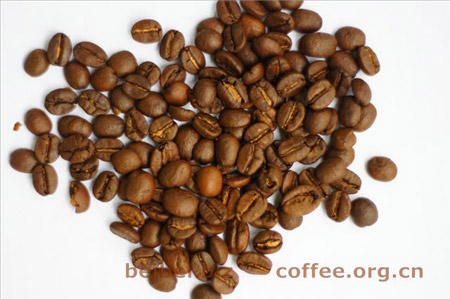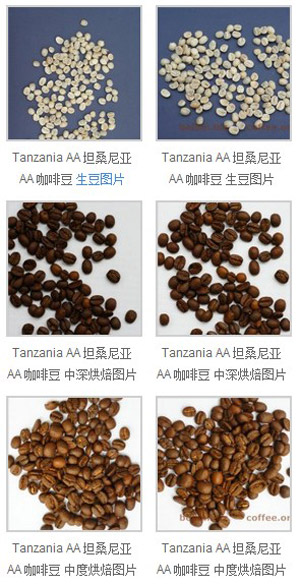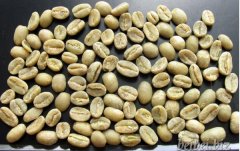Boutique coffee beans Tanzania AA Tanzania AA coffee beans
Tanzania AA Tanzania AA coffee beans are smaller and rounder than most. They look like peas and taste sour, sweet, full-bodied and refreshing, with low acidity and a well-balanced taste. Strong aroma, good aroma.

Tanzania AA AA coffee beans moderate roasting picture in Tanzania
Tanzania AA Tanzania AA coffee beans feature:
1. Palate: sour, sweet, full-bodied and refreshing, low acidity, balanced taste.
two。 Fragrance: strong aroma, good aroma.
3. Vision: particles of the same size, symmetrical.
Tanzania AA Tanzania AA coffee beans are smaller and more round than most coffee beans. They look like peas. Tanzanian coffee beans have different qualities, such as Kilimanjaro coffee. Its delicate aroma, with aromas of wine and fruit, makes people taste endless after tasting. It is very similar to Kenyan coffee in appearance, and its overall taste is more similar to Sumatra Kalou coffee. Tanzania AA Tanzania AA coffee beans always feel a soft, mellow earthy flavor around the mouth. Tanzania AA Tanzania AA coffee beans are roasted moderately or above with a strong aroma and are suitable for use as a single product or iced coffee.
Tanzania AA Tanzania AA Coffee beans description:
The more famous production area is Mount Kilimanjaro, the highest mountain on the African continent, with a height of 3,000 to 6,000 feet, which is the most suitable area for growing coffee; it is rich and refreshing with sweet taste, low acidity, balanced taste and strong aroma.

Tanzania AA Tanzania AA coffee beans medium and deep roasting picture of medium baking
* thanks to Guangzhou foresea for providing samples of African Tanzania AA coffee beans.
Related:
The first experience of AA coffee beans in Tanzania:
Tanzania coffee beans are absolutely comparable to neighboring Kenya, but the quality of coffee in the country is not strictly controlled, and carelessness in many processes often destroys the quality of coffee (such as transportation). Good quality Tanzanian coffee beans are divided into AA and A grade.
The raw beans of this Tanzanian AA coffee bean look neat and have a delightful light green. The roasted Tanzanian AA coffee beans are plump, granulated and similar in shape to Bourbon.
Drip filter brewed city-roasted Tanzanian AA coffee beans, the entrance does not have any unpleasant taste, although insipid, but balanced, but also rich.
Drinking coffee is like looking at life, what is happiness? every day is light is very happy. Tanzania AA coffee beans are such coffee.
Important Notice :
前街咖啡 FrontStreet Coffee has moved to new addredd:
FrontStreet Coffee Address: 315,Donghua East Road,GuangZhou
Tel:020 38364473
- Prev

Boutique coffee learn from Ethiopia and snow coffee raw beans
Yejaschefine is the representative of East African boutique coffee (specialty coffee). It has a very special and unusual aroma of citrus fruit and flowers, which makes it one of the most distinctive coffee in the world, which is rare and expensive. Medium to pointed (delicate) acidity and medium body, smooth and well balanced cup with a creamy
- Next

Boutique Coffee study the types of coffee in common areas of Sumatra, Indonesia
A new variety of coffee from Sumatra, Indonesia, SPECIALTY COFFEES OF SUMATRA REGIONS OF INDONESIA RASUNA Lasuna, a new variety of Sumatra, Indonesia, iron pickup Typica / Katim Catimor hybrid. MANDHELING Mantenin coffee bean Ateng (a kind of catimor Katim) crosses with other Arabica coffee. Sumengda
Related
- Beginners will see the "Coffee pull flower" guide!
- What is the difference between ice blog purified milk and ordinary milk coffee?
- Why is the Philippines the largest producer of crops in Liberia?
- For coffee extraction, should the fine powder be retained?
- How does extracted espresso fill pressed powder? How much strength does it take to press the powder?
- How to make jasmine cold extract coffee? Is the jasmine + latte good?
- Will this little toy really make the coffee taste better? How does Lily Drip affect coffee extraction?
- Will the action of slapping the filter cup also affect coffee extraction?
- What's the difference between powder-to-water ratio and powder-to-liquid ratio?
- What is the Ethiopian local species? What does it have to do with Heirloom native species?

